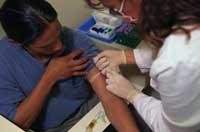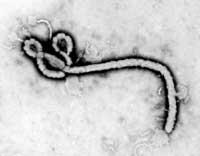Ongoing work against diseases
2004/02/09 Lexartza Artza, Irantzu - Elhuyar Zientziaren Komunikazioa

Scientists dedicated to research in the field of medicine do not have a slow job. Despite the support of new technologies, there are many areas to work. There are diseases that especially concern people. Researchers are constantly working on them.
According to several surveys, cancer is the disease that most worries the population of developed countries. The scientific community seems to agree with this view and is currently making a major effort in research on cancer therapies. A drug that cuts off hemorrhage to tumors has been one of the most important advances in recent months. Thanks to this, they have managed to extend the lives of patients with advanced colon cancer and now try to improve their treatment and adapt to other types of cancer.
Many researchers believe that long-term cancer treatments will be the main model for the future. Mortality rates are expected to decline in a few years. They consider that they lack little to find the genetic structure of many common cancers, which can be a change in some current therapies such as chemotherapy. Asthma
is not a serious disease, but it should be put in the bag of widespread diseases. More than 100 million people suffer in the world and, although most of us do not have it very serious, every year 180,000 patients die. To solve this, biologists create a molecule that prevents airway obstruction during research with asthmatic mice. With this, they have managed to break the flow of mucus in asthma flare-ups. Therefore, the new molecule can be an additional element in the treatment of asthma. However, they should still discuss possible side effects.
There has also been news about meningitis, as some researchers are on track to get a vaccine against all three types. This research has been done with mice to date, with good results. There are currently vaccines against meningitis A and C, but there is no other alternative than B, which is deadly.

The most decisive step is to try new drugs and treatments in humans. This is the case of AIDS and diabetes, which are testing new drugs against them and with positive results, will be a major step forward in their treatment.
On the other hand, although not widespread around the world, Ebola also arouses great curiosity. One of the causes may be high mortality, as approximately 80% of patients infected with the virus die as a result of a disease that has so far only spread in Africa. In recent years there have been five outbreaks in central Africa. It is very infectious and produces fever, liver disorders and internal bleeding.
In 2003, tests were started in humans with an anti-disease vaccine and another vaccine tested with mice has yielded promising results. Studies continue to better understand how the disease affects the immune system, as well as satellite mapping work to map the disease. In addition, a protein that can influence blood clotting is being studied for treatment.
Return of diseases
In addition to the main diseases of recent years, some diseases that were considered almost disappeared for years have gained new strength in developed countries. These diseases are currently treated, but it is not normal that there are many cases. One of them is syphilis. This disease has been detected in several European states and the United States. Health organizations are surprised by the dramatic increase in cases over the past two years. Tuberculosis cases have also increased and some research groups study the genetic structure of this disease.

In addition, the emergence of new epidemics has caused worldwide nervousness: the alleged reappearance of an atypical pneumonia in East Asia has caused concern and researchers have carried out their genetic study.
In Asia, several people have also died from avian influenza. Some experts had already said that viruses of this disease could occur. Experts gathered in London say that animal diseases can be a threat to humans in the coming years. In his opinion, other viruses can also cross the border between species in the future.
On the other hand, technology has experienced advances that can be used in many areas. Interdisciplinary collaboration, the development of alternatives of invasive techniques, digital data processing, etc. have had a great influence on medical research. For example, transplant challenges arise as technology advances. Currently, the shortage of donors is one of the main problems, so research and transplant testing between species has multiplied. These transplants, called xenotransplants, have begun to make genetic changes in the organs to avoid certain problems that may arise. The issue of xenotransplants has already generated controversy over the ethical problems that arise and certain that in the future will continue to arouse more debate.
However, despite advances, some discoveries that aroused hope have not been the expected result. Some have failed to repeat in humans the results obtained in animals or have suffered bad side effects. Of all the expectations that appear each year, only some become reality. The road to disease is still long and we will have to see how the work of researchers develops to see what the results are.
Debate on cloning at the United Nations

This year a debate will be held at the UN headquarters that can have important consequences for research. In September 2004, the United Nations will conclude its debate on cloning. They expect it, at least, because the debate has been delayed on several occasions.
At the heart of the United Nations there are two main opinions, and nothing has been possible for the moment. Everyone believes that the use of human cloning for reproduction must be banned, but consensus ends there. The United States and other countries also want to ban therapeutic cloning, that is, the total ban on cloning. Other States, such as Belgium, France, the United Kingdom or Japan, consider that cloning should be authorized for therapeutic and research uses, as otherwise there could be major barriers to disease therapies.
In the beginning, the law commission proposed postponing the debate until 2005, after the Islamic Conference proposed it, but finally, the peoples who favor the total ban have achieved a delay of one year. The issue of stem cells will also be discussed in the European Union.
The future of research is not safe
Increasing anti-terrorist security measures in the United States can be harmful to research, according to many scientists. Foreign researchers already had trouble entering this country and now studies are hardened to get the visa. In addition, new export regulations and polygraph tests that can be done to special field scientists can endanger the international exchange of ideas. Other states of the world also intend to take such measures.
On the other hand, the economic crisis can also affect medical research. Funding has been declining in most areas for some time, with biodefense still being protected. Its boom in 2003 has no way to change. In this field a thorough investigation of various pathogens has been carried out. For example, they have conducted numerous experiments on botulism, anthrax, plague, hemorrhagic fever and other diseases. While this may involve many advances in itself, many of the results obtained will not be made public.
Rainfall of data in genetic matter.

With the human genome sequence in their hands, biologists have seen that they need much more data to fully understand them. With this objective we are working on different projects. Among other things, attempts will be made to look for models in human genetic changes, obtain information on gene expression, analyze the functions and interactions of proteins, and accurately identify the functions of genes.
In addition, several researchers have expressed their intention to determine genetic differences between species. In this sense, we can expect a flood of information for the coming months.
Several investigations have already begun to bear fruit. In recent months they have created mice without cholesterol, identified the gene responsible for osteoporosis and others related to schizophrenia and depression.
On the other hand, the laboratory has achieved for the first time the spontaneous creation of sperm and eggs. Also, small RNA have seen the importance they have for gene expression and have immersed themselves in the details of this relationship. Among other things, they have seen influence on the initial development of plants and animals and the creation of the immune system.
All the information obtained can be the key to progress in many therapeutic uses.
Published in D2 section of Deia.

Gai honi buruzko eduki gehiago
Elhuyarrek garatutako teknologia




